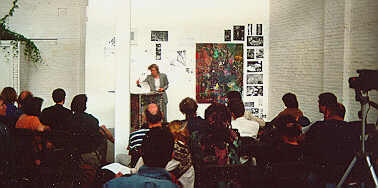Conference, 12 may 1993, Paraplufabriek ,Nijmegen.

I have talked about 50 minutes about the developments in what is
called chaos theory in science. Little by little the audience understood
that determinism and unpredictability doesn't have to exclude one another.
That, often order is hidden in what is considered to be chaotic. That,
complex systems; a combination of order and chaos, can emerge on their
own. And finally, that chaos isn't negative, but a condition for renewal
and so for life.
This conference wasn't meant as an explanation of my art work, but as
a work on its own. It was one of the many forms one can distract from the
chaotic. By means of the conference I moved on the border of the art system.
I included something into it what was strange to it. According to chaos
theory the consequences af such an act are unpredictable. But without disturbance,
every system would loose all its possibilities of evolution. So........
Literature:
*Geowissen, Chaos + Kreativität, Gruner + Jahr Verlag, Hamburg, 1990.
*J. Gleick, Chaos, New York, 1987.
*H.D. Huber, Interview mit Niklas Luhmann, Parkett.
*M Hulspas, Niet al het onvoorspelbare is chaos., Intermediair, 2 juni
1992.
*S.A. Kauffman, Antichaos and adaption, Scientific American, augustus 1991.
*G.J. Lischka, Aktuelles Denken, Kunstforum 108, 1990.
*Maturana & Varela, The tree of knowledge, Shambala, Boston, 1987.
*M. Meisel, Chaos deja-vu, Strange signs of chaos, MOMA, New York, 1989.
*Peitgen & Jürgens & Saupe, Chaos and Fractals, Springer Verlag,
New York, 1992
*R. Pool, Chaos theory, How big an advance?, Science vol. 245.
*Prigogyne & Stengers, Orde uit chaos, 1985.
*Rhizome, katalogus expositie, Haags Gemeentemuseum, 1991.
*V. Sobchack, A theory of everything, Art Forum, oktober 1990.
*P. van Tongeren, Strijden om normen is strijden zonder rugdekking, De
Groene Amsterdammer, 21 juni 1989.
*Varela & Thompson & Rosch,L'inscription corporelle de l'esprit,
Seuil, Paris, 1993.
*P. Vroon, Chaostheorie en menselijk gedrag, De Psycholoog, januari 1992.


